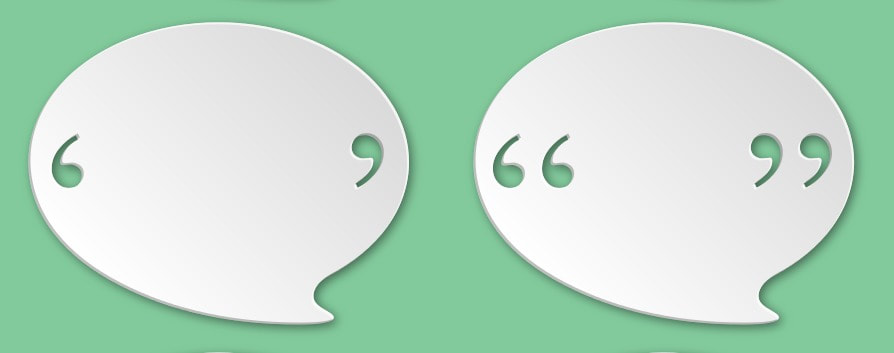|
Quotation marks (also called quote marks, speech marks or inverted commas) are used to mark text that is dialogue or quoted material. They can also be used for ‘scare quotes’ (see what I did there?) to show that a term is sarcastic, slang, a term that would not normally be used in that style of writing, or to isolate the term for attention. Should I use single or double quote marks in New Zealand English?Good question. Newspapers usually use double quote marks, and we were usually taught at school to use them. But you often see single quotation marks too. Have the rules changed? Which way is correct? Is there a correct way? That depends. American English traditionally uses double quotation marks for dialogue, quoted words and phrases, and scare quotes (except in some technical areas) and single quotation marks for quotes within a quote, whereas British English does the reverse and uses mainly single quotation marks with doubles for quotes within a quote. So, where does that leave us in New Zealand? Again, that depends. Check your style guideFirst, check whether your organisation, publisher or tertiary institution has a style guide. If the guide specifies single or double quotation marks, you have your answer. The style guide used by the New Zealand Government and the Write Style Manual for Standards New Zealand prefer single quotation marks. Some academic styles, such as the Harvard style, specify using single quotation marks when citing from books or articles, etc., but double quotation marks when quoting direct speech. On the other hand, if you are writing in APA style, make sure you use double quotation marks throughout. If you don't have a style guideIf you are not bound to a style guide, then you have a choice to make. The New Oxford Style Manual prefers single quote marks, whereas Fit to Print: The Writing and Editing Style Guide for New Zealand allows you the choice for aesthetic preference. Double quotation marks are becoming less popular in New Zealand English books, as single quotation marks give a cleaner look on the page, but singles can also be missed easily when scanning the page. Newspapers tend to use double quotation marks. Educational and children’s books usually use double quotation marks as it makes them more visible to a young reader. Finally, if you are writing for an international audience, check which style your target audience prefers (British, American, Canadian or Australian) and follow those rules. Considering accessibilityAccessibility should always be considered when writing to make sure all readers can access your content. Double quote marks can be easier to see for people with low vision. Being consistentWhichever style you choose, make sure you are consistent within your piece of writing as well as across all your content. Readers pick up on inconsistency, even unconsciously, and it looks careless. See below for a quick reminder on the grammar rules for quotation marks. How to use quotation marksDialogue is the most common place to use quotation marks.
Or when quoting material from a book or article.
When quotation marks are used to mark words that are inconsistent with normal usage, stay consistent to the style. For example, if you used single quotation marks for direct speech, then also use single quotation marks for scare quotes, and vice versa.
For quotes within a quote: If you use single quotation marks, then use double quotation marks for quotes within the quote, and vice versa.
How not to use quotation marksWe often see quotation marks used for emphasis on shop signs and windows. Please do not do this. If you need to emphasise a word, use italics or bold. What next?If you have written content in New Zealand English and this all sounds overwhelming, I can help.
As a business editor and plain language specialist, I will help you publish better business and government content so that
Contact me today to discuss how I can help you achieve your goals with clear, professional writing. Related articles: New Zealand English: Punctuation Inside or Outside Quotation Marks External Sources: Hughes, J., & Wallace, D. (2010). Fit to Print : The Writing & Editing Style Guide for Aotearoa New Zealand. Wellington, New Zealand: Dunmore Publishing. The Chicago Manual of Style Oxford University Press, (2016). New Oxford Style Manual (3rd ed.). United Kingdom: Oxford University Press. Comments are closed.
|
Hi, I'm Marja!You'll find all my advice about creating professional, Categories
All
Previous PostsPlain language
Business editing New Zealand English series The editing process General editing Technical |

